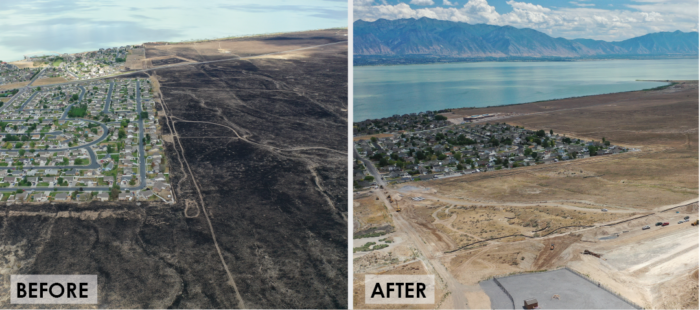Utah Rains Return, But Flood Mitigation Efforts Keep Saratoga Springs Dry

When the fast-moving Knolls wildfire threatened the Saratoga Springs community in 2020, it forced 13,000 residents to evacuate their homes, while hundreds of firefighters battled the 13,000-acre fire throughout the night. As winds gusted up to 57-mile-per-hour, the fire moved dangerously close to nearby neighborhoods.
While no injuries were reported and structural damage was minimal, the fire had a significant impact: a burn scar that left nearby steep hillsides bare and vulnerable, creating concern with officials that flash flooding and debris flows could be the next issue. Engineers from CRS were onsite the day after the fire’s containment to stabilize potential flood areas and mitigate additional water-related damage.
See the video with an aerial view of the fire damage and rehabilitation
The fire burned across seven drainage areas, and the Utah community needed to offset the impact of the bare hillsides against any weather events in the following few months. CRS addressed the immediate stabilization concerns by implementing check dams, silt fencing, reseeding, and channel improvements with locally sourced rock.
In addition, the community obtained federal Natural Resources Conservation Service (NRCS) funds in less than a month for resources to contract for engineering design and construction management for land improvements. They hoped to protect residential areas and developable land from future debris flows and flooding.
Debris Basin Solution
One of the most noticeable flood mitigation enhancements that Saratoga Springs added was the Harbor Parkway Debris Basin, a structure that captures sediment, gravel, boulders, and vegetative debris that could wash out of the nearby canyon during heavy rain. The water from the basin flows into the downstream storm drain system, which reduces the flood risk for Saratoga Springs.
The adequately maintained debris basin will:
- Stop large items such as rocks and debris from leaving the canyon and impacting the watershed
- Keep sediment in the natural surface water system and not in the downstream flood control system
- Reduce flood peaks that may impact nearby houses
See more about CRS’ expertise in stormwater engineering for flood conditions
Monsoon Rains Provide a Test
A robust season of monsoon rains occurred in the summer of 2021 and resulted in flash floods around Utah. Saratoga Springs officials monitored the fire-affected area and the work that CRS had implemented the previous summer. Officials were pleased to see that the drainage system was solid and that flooding was avoided.
Because Saratoga Springs took quick and effective action immediately after the disaster, they were able to take advantage of public support for the construction of the debris basin and reduce the long-term aftermath of the Knolls Fire.
Increased instances of fires, heavy rains, and other meteorological events have forced many Utah municipalities to address flood mitigation.
For more information on how CRS can help your community with flood risk prevention, contact Joshua Prettyman at joshua.prettyman@crsengineers.com.

